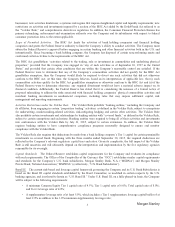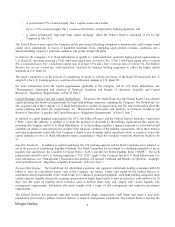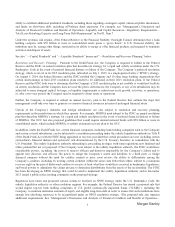Morgan Stanley 2015 Annual Report Download - page 19
Download and view the complete annual report
Please find page 19 of the 2015 Morgan Stanley annual report below. You can navigate through the pages in the report by either clicking on the pages listed below, or by using the keyword search tool below to find specific information within the annual report.
Item 1A. Risk Factors.
For a discussion of the risks and uncertainties that may affect the Company’s future results and strategic goals, see “Forward-
Looking Statements” immediately preceding Part I, Item 1 and “Return on Equity Target” and “Effects of Inflation and
Changes in Interest and Foreign Exchange Rates” under “Management’s Discussion and Analysis of Financial Condition and
Results of Operations” in Part II, Item 7.
Market Risk.
Market risk refers to the risk that a change in the level of one or more market prices, rates, indices, implied volatilities (the
price volatility of the underlying instrument imputed from option prices), correlations or other market factors, such as market
liquidity, will result in losses for a position or portfolio owned by us. For more information on how we monitor and manage
market risk, see “Quantitative and Qualitative Disclosures about Market Risk—Risk Management—Market Risk” in Part II,
Item 7A.
Our results of operations may be materially affected by market fluctuations and by global and economic conditions and
other factors.
Our results of operations have been in the past and may be materially affected by market fluctuations due to global and
economic conditions and other factors, including the level and volatility of equity, fixed income and commodity prices
(including oil prices), interest rates, currency values and other market indices. The results of our Institutional Securities
business segment, particularly results relating to our involvement in primary and secondary markets for all types of financial
products, are subject to substantial market fluctuations due to a variety of factors that we cannot control or predict with great
certainty. These fluctuations impact results by causing variations in new business flows and in the fair value of securities and
other financial products. Fluctuations also occur due to the level of global market activity, which, among other things, affects
the size, number and timing of investment banking client assignments and transactions and the realization of returns from our
principal investments. During periods of unfavorable market or economic conditions, the level of individual investor
participation in the global markets, as well as the level of client assets, may also decrease, which would negatively impact the
results of our Wealth Management business segment. In addition, fluctuations in global market activity could impact the flow
of investment capital into or from assets under management or supervision and the way customers allocate capital among
money market, equity, fixed income or other investment alternatives, which could negatively impact our Investment
Management business segment.
The value of our financial instruments may be materially affected by market fluctuations. Market volatility, illiquid market
conditions and disruptions in the credit markets make it extremely difficult to value certain of our financial instruments,
particularly during periods of market displacement. Subsequent valuations in future periods, in light of factors then
prevailing, may result in significant changes in the values of these instruments and may adversely impact historical or
prospective performance-based fees (also known as incentive fees or carried interest) in respect of certain business. In
addition, at the time of any sales and settlements of these financial instruments, the price we ultimately realize will depend on
the demand and liquidity in the market at that time and may be materially lower than their current fair value. Any of these
factors could cause a decline in the value of our financial instruments, which may have an adverse effect on our results of
operations in future periods.
In addition, financial markets are susceptible to severe events evidenced by rapid depreciation in asset values accompanied
by a reduction in asset liquidity. Under these extreme conditions, hedging and other risk management strategies may not be
as effective at mitigating trading losses as they would be under more normal market conditions. Moreover, under these
conditions market participants are particularly exposed to trading strategies employed by many market participants
simultaneously and on a large scale. Our risk management and monitoring processes seek to quantify and mitigate risk to
more extreme market moves. However, severe market events have historically been difficult to predict and we could realize
significant losses if extreme market events were to occur.
13
























